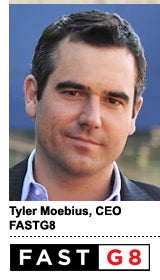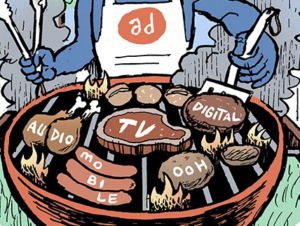 Outdoor lifestyle brands have plenty of room to grow their digital sales, but many hold back for fear of cannibalizing brick-and-mortar distribution, according to ad tech veteran Tyler Moebius.
Outdoor lifestyle brands have plenty of room to grow their digital sales, but many hold back for fear of cannibalizing brick-and-mortar distribution, according to ad tech veteran Tyler Moebius.
Moebius hopes to help these marketers – companies like SmartWool and POC – overcome that paradox with FASTG8 (“fast gate”), his data-driven marketing company based in Carbondale, Colo.
Moebius is a known quantity in digital ad circles. He founded Adconion, which was acquired by Amobee in June. Before that he was director of business development at aQuantive and founder of Traffic Marketplace.
His new company has positioned itself to increase online sales for small and mid-size outdoors brands, whose online sales as a percentage of total sales generally lag behind bigger retailers.
Moebius spoke with AdExchanger about FASTG8 and the problems facing outdoor lifestyle brands in the online retail market.
AdExchanger: What problem does FASTG8 solve?
TYLER MOEBIUS: FASTG8 is helping ecommerce brands to achieve better return on ad spend by better leveraging their own internal and external data.
With a lot of these brands, particularly mid-size ecommerce brands, their biggest challenge is their data is sitting in disparate databases within the organization. They’ll have a Google Analytics account, they’ll have a CRM database, they’ll be using a third-party ad server to execute their media campaigns, and it’s really difficult for them to pull all of this data together on a single platform.
By leveraging cloud-based data-management platforms like Hadoop and Amazon Web Services, we’re able to integrate all of that data onto a single platform and then make that data actionable by executing their media campaigns across our own trading platform.
Why target outdoor lifestyle brands?
There’s a real opportunity today because of the explosive growth from retailers moving to e-tail. That was really underscored by this upcoming holiday shopping season, where online sales were higher than in-store sales on Black Friday.
What we’ve seen with the outdoor ecommerce brands is the majority of them have their own physical retail outlets, and they have been slow to adopt a direct-to-consumer strategy in fear of cannibalizing their in-store sales.
My experience from Adconion has been that your big e-tailers will generate 25-30% of their total sales online. However, when you look at outdoor lifestyle brands they’ve just been slower to adopt the direct-to-consumer channel and they’ll be 5-10% of their total sales. We see a massive opportunity to be able to bring our solution to the active outdoor space and really set a new benchmark in terms of being able to generate 30% of their sales directly to consumers.
What’s your solution?
Today there are three core solutions. Our data-management platform, FAST Dash, helps brands understand their internal data. We make that actionable by executing campaigns as a managed service – that’s the second solution, executing campaigns on their behalf. The third, which we’ll be launching in spring of this year, is the ability for a brand to execute their own campaigns on our platform by having their own terminal on our demand-side platform (DSP).
Who are your competitors?
Generally, for active outdoor lifestyle brands that are doing less than $50 million in online sales – that’s our target market – the competitive set is digital agencies and planners, because FASTG8 works directly with the brand. We understand their data architecture – where all the data sits. We work across the entire organization to integrate that data onto a single platform, and then build custom dashboards for the entire organization. So the C-suite has different data visualization and tools than the creative team.
Then we execute that across our programmatic trading platform on their behalf. We compete more with the small to mid-size digital agencies, or we often are positioning ourselves as an extension of a brand’s in-house ecommerce team by helping to round out that team and bring more expertise around data and technology.
How have you worked with brands?
A great use case is SmartWool. They work with Backbone Media as their planning and buying agency.
In that case, we came in and did a data blueprint to understand where all of the critical marketing data lived within their organization. That included Google Analytics, DoubleClick Manager, their CRM data, their merchant data –product skews and so forth – to better understand shopping cart value, and also any third-party data they might be using to track in-store sales.
We then pull all of that data together – either through APIs or through flat file – and integrate that data onto our data-management platform and normalize that data and make it available at their fingertips through various data visualization tools. This allows them to see in near time the most critical KPIs that are required to run their business.
Each FAST Dash that we implement is custom and aligned with the organization’s goals. We help translate their marketing data into real business goals and business outcomes. Once we do that, we now understand what the return on ad spend targets are – for every dollar they spend in media, what is the revenue target they want to achieve in online.
Then, we execute the campaigns programmatically across various exchanges and publishers to achieve those goals by optimizing and making sure we’re hitting their target audience, their high value segments, optimizing to shopping cart value, order size and so forth.
How are you funded?
Currently we’re self-funded. We achieved profitability within the second month. We’ve got over a dozen clients and we’re running over a $2.5 million run rate. The intention is to continue to self fund from the profits of the company.
What are your goals in the next year or two?
Our goal is to help our clients achieve their goal. FASTG8’s vision is to make advertising a cost of goods sold. What I mean by that is traditionally advertising is a general administration expense. We want to make advertising a cost of goods sold so it’s a variable expense, and every single one of our clients two years from now knows if they spend a dollar on media on the FASTG8 platform, they will get three to four times return on ad spend (through online sales) as a result.
Ultimately the goal, in two to three years, is every single one of our clients is driving 25-30% of their total sales direct-to-consumer online.













